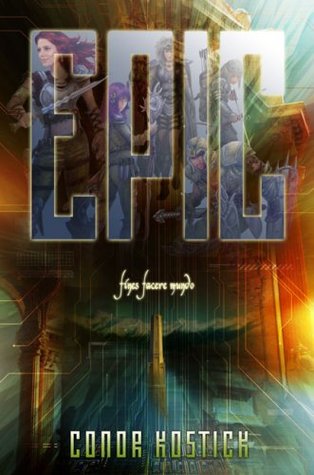 Little Brother
Little Brother
Doctorow, Cory
Tor. 2010. ISBN: 9780765323118
Summary
Marcus Yallow lives in San Francisco in a not-so-distant future. He is a typical teenager, but he is also a computer geek and a hacker always looking for ways to bypass the system, including his school’s unnecessary security systems. When he and his friends skip school to get ahead in the Alternative Reality Game (ARG) called Harajuku Fun Madness, they find themselves in the midst of a terrorist attack on San Francisco. They are taken in to be questioned by the Department of Homeland Security. When he is released after days of questioning, Marcus is warned by the DHS that he will be watched by them and one wrong move will get him back to the DHS holding facility. But Marcus does not go back to the San Francisco he knows, but one that is under strict surveillance by the DHS, where the residents’ privacy and freedoms are violated on regular basis. Now Marcus has to put his hacking skills to use to fight back for his rights and for those of his fellow residents.
Critical Evaluation
Cory Doctorow’s futuristic novel is relevant to teens because of its topics of technology, privacy, and freedom. Those topics are relevant to today’s world, and also interesting from a teens’ perspective. In Marcus’ world, adults are always coming up with futile ways to be safe, and the teens are always finding ways to bypass those security measures. This raises the question: if a few tech-savvy teens can bypass those securities, what would prevent terrorists from doing the same thing? The book is about questioning authority, whether it is teachers, parents, or the government. Doctorow raises these questions through an engaging story that is a page turner. Because many of today’s teens are so well-versed in technology, the book really speaks to them in a way that other books may not. If the fear of faraway military dictatorships might be too abstract, concerns about privacy and security are all too clear. In a country where freedom is a priority, not many people are concerned with a few privacy violations. However, what would happen if the government found an excuse to collect and view all the information? The book does a good job in showing that in the hands of a corrupt government, seemingly harmless things like bus passes recording everyone’s riding patterns might be a reason to mark someone as a terrorist suspect.
The writing is appropriate for reluctant readers, although the many references to technology create a conundrum. The author wanted the book to be accessible to those who like technology and also to those who are not familiar with the book’s jargon. Therefore, he explains in detail many of the technology references included. However, this might not be a good solution, as it is possible that those who are not interested in technology might still find the jargon boring, while those who are experts might get inundated by all the explanations.
Overall, the book addresses topics appropriate to today’s world in a way that is of interest to teens. The subject matter makes the book appropriate for reluctant readers, especially boys.
Reader’s Annotation
In the aftermath of a terrorist attack on San Francisco, Marcus Yallow and his friends are questioned by the Department of Homeland Security as terrorist suspects. After being released, Marcus goes back to a world where anyone can be taken in to be questioned as suspects, and he has to find ways to fight for his rights.
About the Author
“Cory Doctorow (craphound.com) is a science fiction novelist, blogger and technology activist. He is the co-editor of the popular weblog Boing Boing (boingboing.net), and a contributor to The Guardian, the New York Times, Publishers Weekly, Wired, and many other newspapers, magazines and websites. He was formerly Director of European Affairs for the Electronic Frontier Foundation (eff.org), a non-profit civil liberties group that defends freedom in technology law, policy, standards and treaties. He holds an honorary doctorate in computer science from the Open University (UK), where he is a Visiting Professor; in 2007, he served as the Fulbright Chair at the Annenberg Center for Public Diplomacy at the University of Southern California.
His novels have been translated into dozens of languages and are published by Tor Books, Titan Books (UK) and HarperCollins (UK) and simultaneously released on the Internet under Creative Commons licenses that encourage their re-use and sharing, a move that increases his sales by enlisting his readers to help promote his work. He has won the Locus and Sunburst Awards, and been nominated for the Hugo, Nebula and British Science Fiction Awards. His latest young adult novel is HOMELAND, the bestselling sequel to 2008’s LITTLE BROTHER. His latest novel for adults is RAPTURE OF THE NERDS, written with Charles Stross and published in 2012. His New York Times Bestseller LITTLE BROTHER was published in 2008. His latest short story collection is WITH A LITTLE HELP, available in paperback, ebook, audiobook and limited edition hardcover. In 2011, Tachyon Books published a collection of his essays, called CONTEXT: FURTHER SELECTED ESSAYS ON PRODUCTIVITY, CREATIVITY, PARENTING, AND POLITICS IN THE 21ST CENTURY (with an introduction by Tim O’Reilly) and IDW published a collection of comic books inspired by his short fiction called CORY DOCTOROW’S FUTURISTIC TALES OF THE HERE AND NOW. THE GREAT BIG BEAUTIFUL TOMORROW, a PM Press Outspoken Authors chapbook, was also published in 2011.
LITTLE BROTHER was nominated for the 2008 Hugo, Nebula, Sunburst and Locus Awards. It won the Ontario Library White Pine Award, the Prometheus Award as well as the Indienet Award for bestselling young adult novel in America’s top 1000 independent bookstores in 2008.
He co-founded the open source peer-to-peer software company OpenCola, sold to OpenText, Inc in 2003, and presently serves on the boards and advisory boards of the Participatory Culture Foundation, the Clarion Foundation, The Glenn Gould Foundation, and the Chabot Space & Science Center’s SpaceTime project” – About Cory Doctorow
Website: http://craphound.com/
Genre
Science Fiction
Curriculum Ties
N/A
Booktalking Ideas
- Describe Marcus’ life before the attack and his interest in computers and ARGs.
- Discuss issues of privacy and security.
Interest/Reading Level
Grade 9+/ATOS 5.9
Challenge Issues: sexually explicit
Challenge Defense Ideas:
- Have a copy of the American Library Association Library Bill of Rights to show/give to patron.
- In addition to, or in place of the above, explain library policy of inclusion of information that might be controversial. For example, Pasadena Public Library, Philosophy of Selection. Have a printed copy ready, with appropriate sections highlighted.
- Explain the parental rights and responsibilities with their children’s library use. Explain the different card designations and the parents’ right to monitor or restrict borrowing of materials.
- Depending on the library’s policy, either have paperwork to fill out for formal challenges, or the contact information of those who handle challenges.
- Give examples of book reviews from School Library Journal, Library Journal, or BookList. Note any awards that the book received.
Reasons for Inclusion
Topics relevant to teens (technology, privacy). Appeal to reluctant readers.
 The book starts with a boy drowning. He drowns. He wakes up in his childhood home in England, except it looks like it had been abandoned for decades. Everything is as he remembers, even the prison looming forebodingly close to his house and in his memory, but everything is covered in dust and unusable with age. He believes that he is in hell, forced to wake up every day in the house and in the country his family was more than happy to leave behind. But is there more to it than being his own private hell? When he finds out that he is not alone there, is it because he created others out of his imagination or do they exist independent of him?
The book starts with a boy drowning. He drowns. He wakes up in his childhood home in England, except it looks like it had been abandoned for decades. Everything is as he remembers, even the prison looming forebodingly close to his house and in his memory, but everything is covered in dust and unusable with age. He believes that he is in hell, forced to wake up every day in the house and in the country his family was more than happy to leave behind. But is there more to it than being his own private hell? When he finds out that he is not alone there, is it because he created others out of his imagination or do they exist independent of him?
